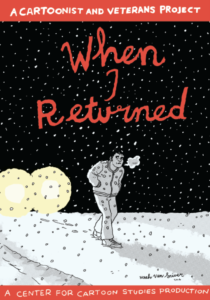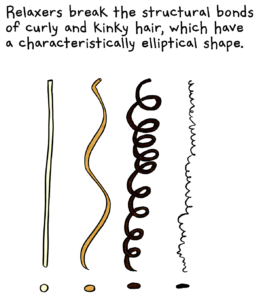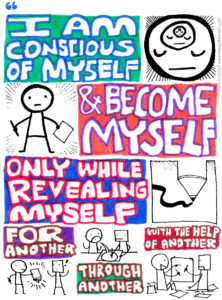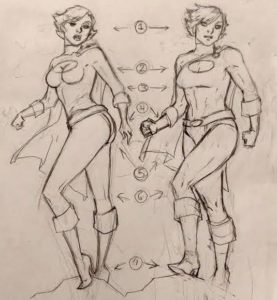Compiled by the Ethnographic Cartooning Roundtable
Afonso, Isabel and M. J. Ramos. “New graphics for old stories. Representation of local memories through drawings.” Working Images: Visual Research and Representation in Ethnography. Eds. Pink, L. Kürti, and A. I. Afonso. Routledge London. 2004. Pp. 72-90.
Atkins, Michael. The Dark Side of the Village. Nd. https://comicsforum.files.wordpress.com/2012/02/dark-side-of-the-village.pdf. (Accessed 2018-04-26).
Bartoszko, Aleksandra, Anne Birgitte Leseth and Marcin Ponomarew. Public Space, Information Accessibility, Technology and Diversity at Oslo University College. 2010. https://anthrocomics.wordpress.com/. (Accessed 2019-09-19).
Causey, Andrew. “’You’ve got to draw it if you want to see it’: Drawing as an Ethnographic Method.” Teaching Culture. 2015.
http://www.utpteachingculture.com/youve-got-to-draw-it-if-you-want-to-see-it-drawing as-an-ethnographic-method/. (Acessed 2018-04-26).
Causey, Andrew. Drawn to See: Drawing as an Ethnographic Method. Toronto: University of Toronto Press, 2019.
Chute, Hilary. Disaster Drawn: Visual Witness, Comics, and Documentary Form. Harvard University Press, Cambridge, MA, 2016.
Cleto, Sara and Erin Kathleen Bahl. 2017. Interview with Erin Kathleen Bahl. https://throughthetwistedwoods.wordpress.com/2017/04/27/interview-with-erin-kathleen-bahl/
Colloredo-Mansfeld, Rudi. “The Value of Sketching in Field Research.” Anthropology UCLA. 16 (1) (1993).
Colloredo-Mansfeld, Rudi. “Space Line and Story in the Invention of an Andean Aesthetic.” Journal of Material Culture. 16 (1) (2011): 3-23.
Crowther, Gillian. “Fieldwork Cartoons.” Cambridge Journal of Anthropology. 14 (2) (1990): 57-68.
Crowther, Gillian. “Fieldwork Cartoons Revisited.” Teaching Culture. 2015.
http://www.utpteachingculture.com/fieldwork-cartoons-revisited/. (Accessed 2018-04-26.)
Dix, Benjamin, Reminder Kaur and Linsay Pollock. “Drawing-Writing Culture: The Truth-Fiction Spectrum of an Ethno-Graphic Novel on the Sri Lankan Civil War and Migration” Visual Anthropology Review, Vol. 35, Issue 1. 2019. pp. 76–111.
Galman, Sally. “The truthful messenger: visual methods and representation in qualitative research in education.” Qualitative Research 9 (2) (2009): 197-217.
Hamdy, Sherine, Coleman Nye, Sarula Bao and Caroline Brewer. Lissa: A Story about Medical Promise, Friendship, and Revolution. New York: University of Toronto Press, 2017.
Hendrickson, Carol. “Visual Fieldnotes: Drawing Insights in the Yucatan.” Visual Anthropology Review, 24 (2) (2008): 117-132.
Hendrickson, Carol. Ethno-Graphics: “Keeping Visual Field Notes in Vietnam. Expedition,” The Magazine of the University of Pennsylvania Museum of Archaeology and Anthropology, 52 (1) (2010): 31-39.
Hendrickson, Carol. “Drawing Insights in Vietnam,” Education About Asia. 20 (3) (2015): 64-66.
Hendrickson, Carol. “Drawing in the Dark: Seeing, Not Seeing, and Anthropological Insight.” Anthropology and Humanism, Vol. 44, Issue 2. 2019. pp 198–213
Hoffmann-Dilloway, Erika. 2016a. “Chatting While Water Skiing, Pt. 1.” Teaching Culture. http://www.utpteachingculture.com/chatting-while-waterskiing-part-1/. (Accessed 2019-12-10).
Hoffmann-Dilloway, Erika. 2016b. “Chatting While Water Skiing, Pt. 2.” Teaching Culture. http://www.utpteachingculture.com/chatting-while-waterskiing-part-2/ (Accessed 2019-12-10).
Hoffmann-Dilloway, Erika. 2016c. “Chatting While Water Skiing, Pt. 3.” Teaching Culture. http://www.utpteachingculture.com/chatting-while-waterskiing-part-3/ (Accessed 2019-12-10).
Ingold, Tim. (Ed.). Redrawing Anthropology. London: Routledge, 2011.
Kuttner, Paul J., Nick Sousanis and Marcus B. Weaver-Hightower. “How to Draw Comics the Scholarly Way: Creating Comics-Based Research in the Academy.” Handbook of Arts-Based Research. Ed. Leavy, Patricia, 396-422. New York: Guilford Press, 2018.
Open Door Clinic, Vermont Folklife Center, UVM Extension Bridges to Health, UVM Anthropology, and Marek Bennett’s Comics Workshop. n.d. The Most Costly Journey. https://opendoormidd.org/most-costly-journey/
Pigg, Stacy Leigh and Cristina Moretti. 2014. Comics and the Ethnographic Imagination. https://imaginative-ethnography.com/2015/11/04/comics/
Taussig, Michael. I Swear I Saw This. University of Chicago Press, Chicago, 2011.
Vermont Humanities Council. “After the Crossing.” Before Your Time Podcast. https://www.beforeyourtime.org/after-the-crossing/
Wadle, Hannah. “Anthropology goes Comics.” Comics Forum. 2012.
https://comicsforum.org/2012/02/03/anthropology-goes-comics-by-hannah-wadle/. Last accessed 2020-01-06.
Walrath, Dana. Aliceheimer’s: Alzheimer’s Through the Looking Glass. Penn State University Press, 2016.
Wright, Lucy. “Ethnographics.” 2018. https://www.vermontfolklifecenter.org/fieldnotes/culture-through-comics-wright. Last accessed 2020-01-07.









